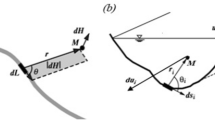Abstract
The computational aspects of using a new, entropy-based, theory to predict water quality values at discontinued water quality monitoring stations are discussed. The main computational issues addressed are the level of discretization used in converting the continuous probability distribution of water quality values to the discrete levels required for the entropy function, and the choice of the interval of time for which to assign the value of the water quality (period of time averaging) through the entropy function. Unlike most cases of entropy applications involving discretization of continuous functions the results of using entropy theory to predict water quality values at discontinued monitoring stations in this application appear to be insensitive to the choice of the level of discretization even down to the very coarse level discretization associated with only eight intervals. However, depending on the length of record available the choice of the time interval for which the water quality values are assigned (period for time averaging) appear to have a significant impact on the accuracy of the results.
Similar content being viewed by others
References
Awumah, K.; Goulter, I.; Bhatt, S. 1990: “Assessment of Reliability in Water Distribution Networks Using Entropy Based Measures”, Stochastic Hydrology and Hydraulics, 4, 309–320
Awumah, K.; Goulter, I.; Bhatt, S. 1991: “Entropy Based Redundancy Measures in Water Distribution Network Design”, Journal of Hydraulic Engineering, ASCF 117(10), 595–614
Awumah, K; Goulter, I. 1992: “Maximising Entropy Defined Redundancy of Water Distribution Networks”, Engineering Optimisation 20(11), 57–80
Chiu, C. 1987: “Entropy and Probability Concepts in Hydraulics”, Journal of Hydraulic Engineering, ASCE 113(5), 583–600
Chiu, C. 1988: “Entropy and 2-D Velocity Distribution in Open Channels”, Journal of Hydraulic Engineering, ASCE 114(7), 738–756
Chiu, C. 1989: “Velocity Distribution in Open Channels Flow”, Journal of Hydraulic Engineering, ASCE 115(5), 576–594
Chiu, C. 1991: “Application of Entropy Concept in Open Channel Flow Study”, Journal of Hydraulic Engineering, ASCE 117(5), 615–628
Chiu, C.; Chiou, J.D. 1986: “Structures of 3-D Flow in Rectangular Open Channels” Journal of Hydraulic Engineering, ASCE 112(11), 1050–1068
Harmancioglu, N.B. 1984: “Entropy Concept as used in Determination of Optimum Sampling Intervals”, Proceedings of Hydrosoft '84, International Conference on Hydraulic Engineering Software, Portoroz, Yugoslavia, 6–99
Harmancioglu, N.B.; Alpaslan, N. 1992: “Water Quality Monitoring Network Design A Problem of Multi-Objective Decision Making”, Water Resources Bulletin, A.W.R.A., 28(1), 179–192
Harmancioglu, N.B; Baran, T. 1989: “Effects of Recharge System on Hydrologic Information Transfer Along Rivers”, IAHS, Proc. of the Third Scientific Assembly of the International Association of Hydrologic Science — New Directions for Surface Water Modelling, IAHS Publ. 181, 223–233
Harmancioglu, N.B.; Yevjevich, V.; Obeysekera, J.T.B. 1985: “Measures of Information Transfer Between Variables”, Proceedings of Fourth International Hydrology Symposium, July 15–17, 1985, 481–499
Harmancioglu, N.B.; Yevjevich, V. 1987: “Transfer of Hydrologic information Among River Points”, Journal of Hydrology 91, 103–118
Jaynes, E.T. 1957: “Information Theory and Statistical Mechanics”, Physical Review 106, 620–630
Jaynes, E.T. 1968: “Prior Probabilities” IEEE Transactions on System Science and Cybernetics 4(3), 227–241
Jaynes, E.T. 1983: “Papers on Probability Statistics and Statistical Physics”, D. Reidel Publishing Company, Dordrecht, Holland, 434 p
Kapur, J.N., 1983, “Twenty five years of maximum entropy principle”, Journal of Mathematical Physical Science, 17(2), pp 103–156.
Kapur, J.N. 1989: “Maximum Entropy Models in Science and Engineering”, Wiley Eastern Ltd., New Delhi, India, 635 p
Kusmulyono, A.; Goulter, I. 1994: “Entropy Principles in the Prediction of Water Quality Values at Discontinued Monitoring Stations”, Stochastic Hydrology and Hydraulics (This issue)
Lasdon, L.S.; Waren, A.D. 1986: “GRG2 User's Guide Department of General Business Administration”, The University Texas at Austin, Austin, Texas, 60 p
Shannon, C.E. 1948: “A Mathematical Theory of Communication”, Bell System Technical Journal 27(3), 379–423, 623–659
Sonuga, J.O. 1972: “Principle of Maximum Entropy in Hydrologic Frequency Analysis”, Journal of Hydrology 17, 177–191
Sonuga, J.O. 1976 “Entropy Principle Applied to the Rainfall-Runoff Process”, Journal of Hydrology 30, 81–94
Author information
Authors and Affiliations
Rights and permissions
About this article
Cite this article
Kusmulyono, A., Goulter, I. Computational aspects in use of entropy theory in predicting water quality levels at discontinued stations. Stochastic Hydrol Hydraul 9, 215–237 (1995). https://doi.org/10.1007/BF01581720
Issue Date:
DOI: https://doi.org/10.1007/BF01581720




